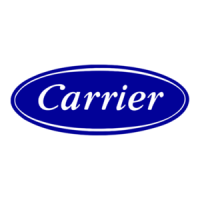• control of the economizer damper and indoor fan to obtain
unoccupied free cooling
• provide power exhaust output to an external power ex-
haust controller
• support a field test for field checkout
• control of 2 stages of power exhaust
• compressor Time Guardt device (power up and minimum
off and on times)
• compressor lockout during low supply-air temperature
Additional features are provided by accessing the stand-
ard unit control board via software with a computer. These
features are:
• electronic expansion board features (if installed)
• control board diagnostics
• ability to change supply air set point (economizer control)
• ability to change high outdoor-air temperature lockout set
point (economizer control)
• ability to change power exhaust set points
NOTE: A unit without a thermostat requires a field-supplied
sensor for operation.
FEATURES WITH SENSOR CONTROL OF UNIT (Stand-
Alone Applications) — Unit control is limited to unoccu-
pied default set points, 90 F for cooling, 55 F for heating.
There are 2 sensor options available:
• T-55 sensor will monitor room temperature and provide
unoccupied override capability (1 hour)
• T-56 sensor will monitor room temperature, provide un-
occupied override capability (1 hour), and provide a tem-
perature offset of ± 5° F.
Standard features are:
• support of remote occupied/unoccupied input to start and
stop the unit
• cooling capacity control of 3 stages using economizer and
2 compressors to maintain space temperature to an occu-
pied or unoccupied set point
• enable heating or cooling during unoccupied periods as
required to maintain space temperature within the un-
occupied set points
• adjustment of space temperature set points of ± 5° F when
using a T-56 sensor
Features with sensor control of unit with computer access
are:
• 365-day timeclock with backup (supports minute, hour, day
of week, date, month, and year)
• daylight savings time function
• occupancy control with 8 periods for unit operation
• holiday table containing up to 18 holiday schedules
• temperature compensated start to calculate early start times
before occupancy
• access to the Display, Maintenance, Configuration, Serv-
ice, and Set Point data table through network software
When the unit is equipped with a field-supplied space tem-
perature sensor and a remote contact closure (remote start/
stop) on the base control board, the occupied default set points
will monitor unit operation. The occupied default set points
are 78 F cooling and 68 F heating. See Fig. 8 for remote
start/stop wiring.
NOTE: For units (with a field-supplied space temperature
sensor) which have not had the base unit control board
accessed via software to set an occupancy schedule, the
remote start/stop closure will allow the unit to operate in the
pre-configured occupied default set points (based on return-
air temperature) of 78 F cooling and 68 F heating. Without
this feature, the unit will control to the unoccupied default
set points of 90 F cooling and 55 F heating.
An electronic expansion board may be field-installed to
provide the following features:
• control of modulating economizer damper to maintain
indoor air quality (IAQ) when outdoor conditions are
suitable
NOTE: The IAQ sensor must be set for current output
(4 to 20 mA) not for voltage output. Ensure the jumper on
the sensor is in the upper position. See Fig. 9.
• provide discrete inputs for fan status, filter status, field-
applied status, and demand limit
• provide an output for the external alarm light indicator
• provides power exhaust fire outputs for direct control of
modulated power exhaust stages during fire or smoke modes
• smoke control modes including evacuation, smoke purge,
pressurization, and fire shutdown (modulating power ex-
haust required)
When the unit is connected to the CCN (Carrier Comfort
Network), the following expansion board features can be
utilized.
• perform Demand Limit functions based on CCN loadshed
commands or the state of the discrete input
• alarm monitoring of all key parameters
• CCN protocol
Table 3 — Controls Options and Configurations (Non-Thermostat Applications)
UNIT CONFIGURATION DEFAULT COOLING DEFAULT HEATING
Unit with SPT Sensor
Unoccupied Cooling — 90 F (SPT)
Occupied Cooling — NA
Unoccupied Heating — 55 F (SPT)
Occupied Heating — NA
Unit with SPT Sensor and Remote
Start/Stop Switch
Unoccupied Cooling — 90 F (SPT)
Occupied Cooling — 78 F (SPT)
Unoccupied Heating — 55 F (SPT)
Occupied Heating — 68 F (SPT)
LEGEND
NA — Not Available
SPT — Space Temperature
NOTE: Space temperature sensor and remote stop/switch are field-
supplied.
R
Y1
Y2
W1
W2
G
C
X
CONTROL
BOX
REMOTE
START/STOP
SWITCH
(FIELD-SUPPLIED)
Fig. 8 — Field Control Remote Start/Stop
LEGEND
Field-Supplied Wiring
8

